Frum Long Island warned: Don’t ignore reality of addiction
For the first time since her son, Aryeh Natan Glassman, died of a heroin overdose in May, one month shy of turning 28, Rebecca Glassman publicly delivered her message that the Orthodox Jewish community needs to address the current drug abuse crisis.
She addressed a packed audience at the Woodmere firehouse on Dec. 14. (The text of her prepared remarks are on page 23.)
Aryeh was one of 93 people of the Orthodox Jewish community in the metropolitan area to die of an overdose or a substance abuse-related incident such as a vehicular accident since September of 2015, according to Rabbi Zvi Gluck, founder and director of Manhattan-based Amudim, an organization that helps young people overcome sexual, physical and substance abuse.
“The stigma attached with addiction is no longer being brushed under the rug, the turnout here shows the tide is turning,” said Gluck. “I do not know of a yeshiva high school in our [Orthodox Jewish] community that doesn’t have drugs in it.”
Glassman was measured in her words as she recounted Aryeh’s brief life that impacted not only her family but also others who knew her son.
“Friends always said that ‘Aryeh had my back’ and he organized hockey games on our street,” the West Hempstead resident said. “He played the piano, he jammed with friends, he loved cooking, and he loved his younger brother and sister,” she added. The Glassman family includes husband, Kenneth, and daughter Pamela, 26, and son David, 22.
Glassman previously addressed her son’s death after 12 years of addiction in print, but this was the first time she openly spoke about Aryeh. A video montage of family photographs was shown before her talk.
“He was extremely bright and absorbed everything,” Glassman later told a reporter about her son who attended yeshiva from age 3 through high school. “He was thrown out of the classroom and put into the resource room. They didn’t want to deal with him.”
Aryeh was treated at least six times in rehabilitation centers in the local area and the Midwest, was in a sober-living facility twice and attended outpatient therapy many times, to no avail, Glassman said.
Too many yeshivas and the Orthodox community are ignoring Long Island’s substance-abuse crisis, specifically the heroin and opioid-based prescription painkiller epidemic, according to Menachem Poznanski, clinical director of The Living Room, a recovery center in Brooklyn and upstate Wesley Hills that is part of Our Place, a haven for Jewish youth grappling with substance abuse, problems at home or being expelled from school.
“Denial is the biggest stumbling block,” said Poznanski, a Cedarhurst resident who spoke about addiction and dependency, and echoed Gluck’s statement about drugs not discriminating between a secular person and an Orthodox Jew or a young person who attends public school or one who is enrolled in a yeshiva.
Reisa Berg, director of education and prevention for the Long Island Council on Alcoholism and Drug Dependence, and Marcie Siciliano, an assessment referral and education specialist for LICADD, presented the practical side of dealing with an opioid overdose.
Berg and Siciliano addressed the new step on the ladder to substance abuse: For many years, the lowest rung was cigarette smoking which might lead to drinking beer and/or wine before moving on to liquor and marijuana. Then the use of synthetic drugs such as Ecstasy were added before graduating to cocaine, heroin, crystal methamphetamine (meth) and crack cocaine. Now prescription opioids are the step in between liquor and marijuana and the synthetic drug rungs.
“People on opioid prescriptions are 40 times more likely to become addicted to heroin,” Berg said.
She also discussed the steps of administering naloxone — the trademarked product Narcan that reverses the effects of an opioid overdose, which typically begins with slowed breathing and then escalates to attacking the central nervous system before possibly leading to death.
Berg pointed out that more than one of the syringe-administered doses (through the nasal passages) could be needed, and Siciliano stressed that the police should be called to help ensure that multiple doses will be available when trained emergency medical technicians arrive at the scene. New York state’s Good Samaritan law protects nonmedical people from liability in this emergency situation, Berg said.
She also said that people overcoming an overdose are possibly irritable, but not usually physically violent, and that Hatzalah ambulances carry the anti-overdose treatment. .
Bradley Heckman, a Nassau BOCES
school psychologist, took notes throughout the forum.
“This was a triple threat for me as I really gained a perspective — emotionally, clinically and therapeutically,” said Heckman, adding that he grew up in Great Neck, his parents live in Woodmere and he resides in Riverdale.
Jeff Bessen is editor of the Nassau Herald.

 65.0°,
Mostly Cloudy and Windy
65.0°,
Mostly Cloudy and Windy 




